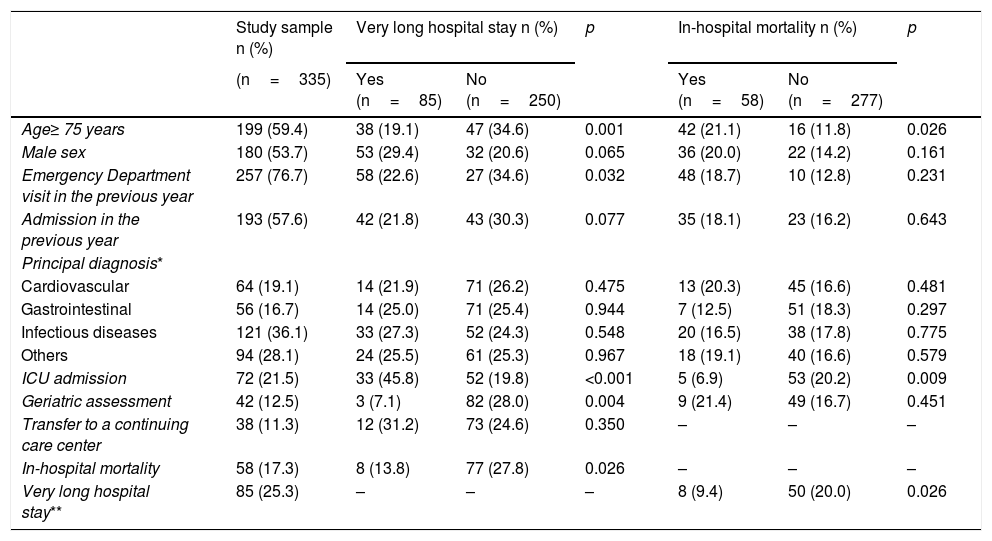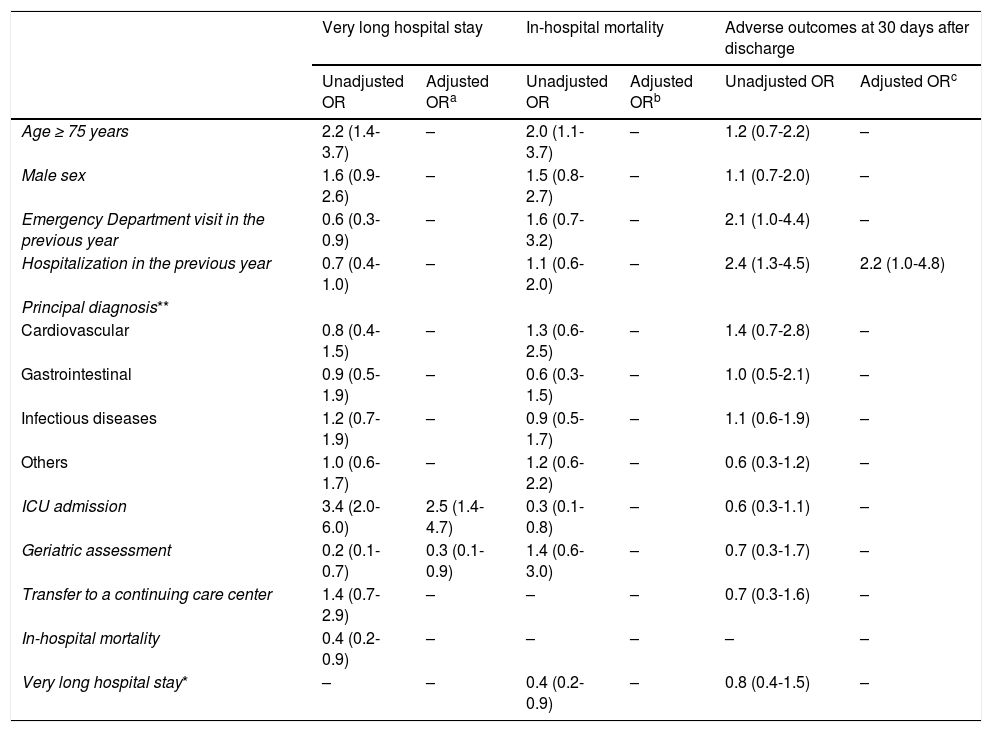To describe the characteristics and short-term prognostic factors of patients with prolonged stay in internal medicine.
Material and methodsRetrospective case series study including patients admitted to an Internal Medicine service of a university hospital with lengths of stay greater than 30 days during 5 years. Information was obtained from the Minimum Basic Data Set. Outcome variables were a very long length of stay, in-hospital mortality, and adverse outcomes in the first 30 days after discharge.
ResultsOut of 11,948 patients, 335 (2.8%) cases had a prolonged stay. The total length of stay was 15,271 days (15% of the total length of stay of the service). The mean age was 74.5 (±13.9) years, 180 (53.7%) were male. The median length of stay was 39 (RIC 34-49) days. Intensive Care Unit admission (OR = 2.5; 95%CI 1.4-4.7; p = 0.003) and receiving a geriatric assessment (OR = 0.3; 95%CI 0.8-0.9; p = 0.042) were independent factors with an effect on very long length of stay. Having an admission in the previous year was an independent factor for an adverse outcome 30 days after discharge (OR = 2.2; 95%CI 1.0-4.8).
ConclusionsThe percentage of patients with prolonged length of stay is less than 3%, but they have a high impact on the activity of an internal medicine service. There are factors associated with a very long length of stay and with the presence of an early adverse outcome after discharge.
Describir las características y los factores pronósticos a corto plazo de los pacientes con estancia prolongada en Medicina Interna.
Material y métodosEstudio retrospectivo de una serie de casos que incluyó pacientes ingresados en un servicio de Medicina Interna de un hospital universitario con tiempos de estancia mayor de 30 días durante cinco años. La información se obtuvo del Conjunto Mínimo Básico de Datos. Las variables de resultado fueron tiempo de estancia muy prolongada, mortalidad intrahospitalaria y resultados adversos en los primeros 30 días tras el alta.
ResultadosDe un total de 11.948 pacientes, 335 (2,8%) tuvieron una estancia prolongada. El tiempo total de estancia fue de 15.271 días (15% del total de tiempo de estancia del servicio). La edad media fue de 74,5 (±13,9) años, siendo 180 (53,7%) varones. La mediana de tiempo de estancia fue de 39 (RIC 34-49) días. El ingreso en la Unidad de Cuidados Intensivos (UCI) (OR = 2,5; IC 95% 1,4-4,7; p = 0,003) y recibir una valoración geriátrica (OR = 0,3; IC 95% 0,8-0,9; p = 0,042) fueron factores independientes con efecto en el tiempo de estancia muy prolongado. Un ingreso hospitalario en año previo fue un factor independiente de un resultado adverso a los 30 días tras el alta (OR = 2,2; IC 95% 1,0-4,8).
ConclusionesEl porcentaje de pacientes con estancias prolongadas es menor de un 3%, pero tienen un alto impacto en la actividad de un servicio de Medicina Interna. Existen factores asociados con el tiempo de estancia muy prolongada y con la presencia de un resultado adverso precoz tras el alta.
Article
Diríjase desde aquí a la web de la >>>FESEMI<<< e inicie sesión mediante el formulario que se encuentra en la barra superior, pulsando sobre el candado.

Una vez autentificado, en la misma web de FESEMI, en el menú superior, elija la opción deseada.

>>>FESEMI<<<









